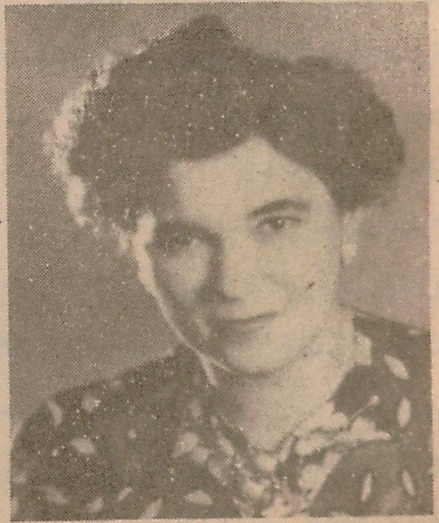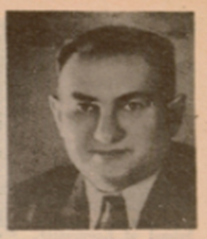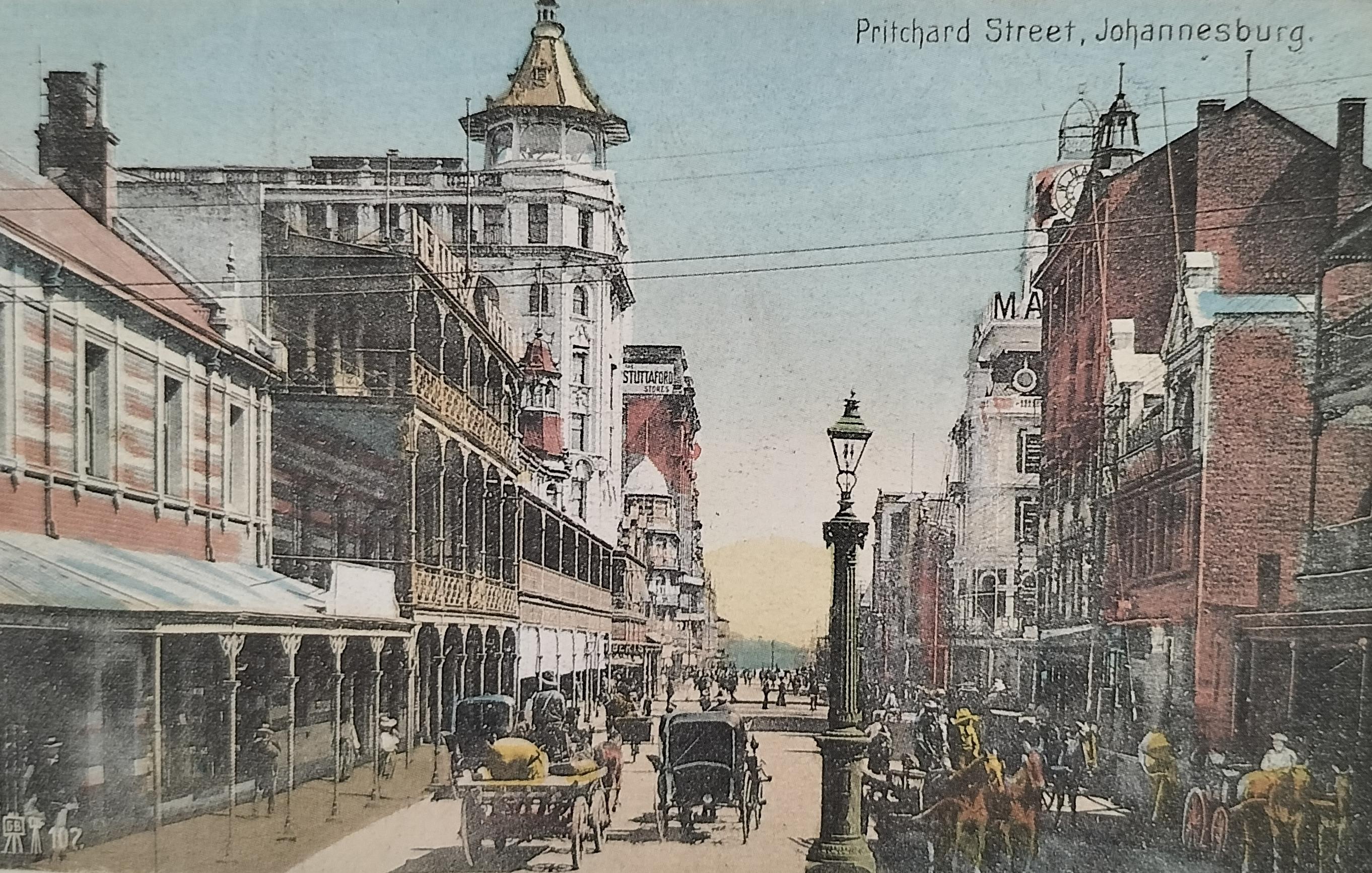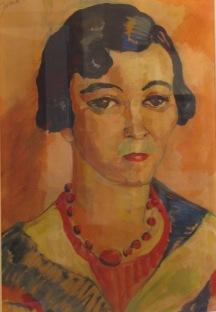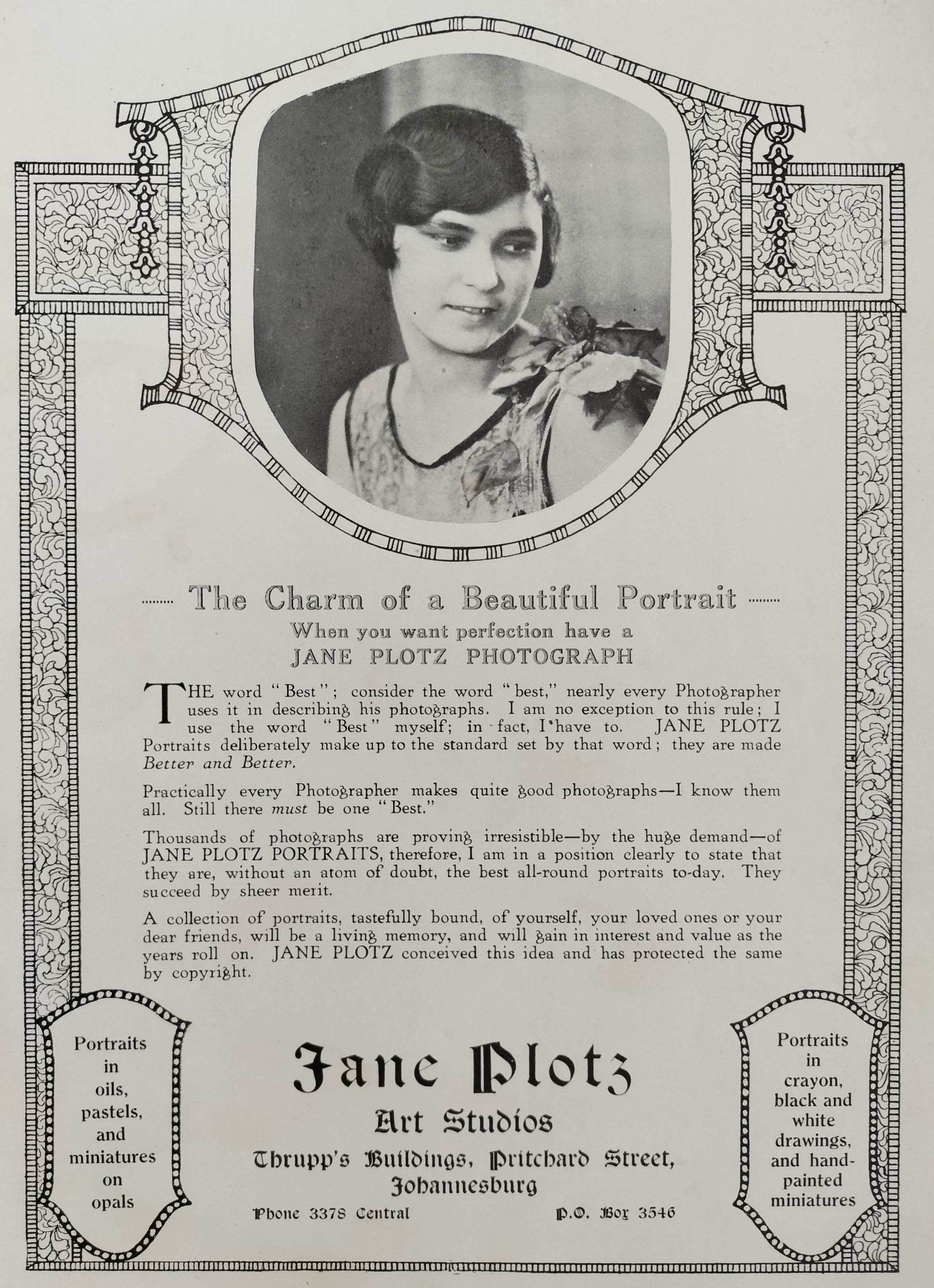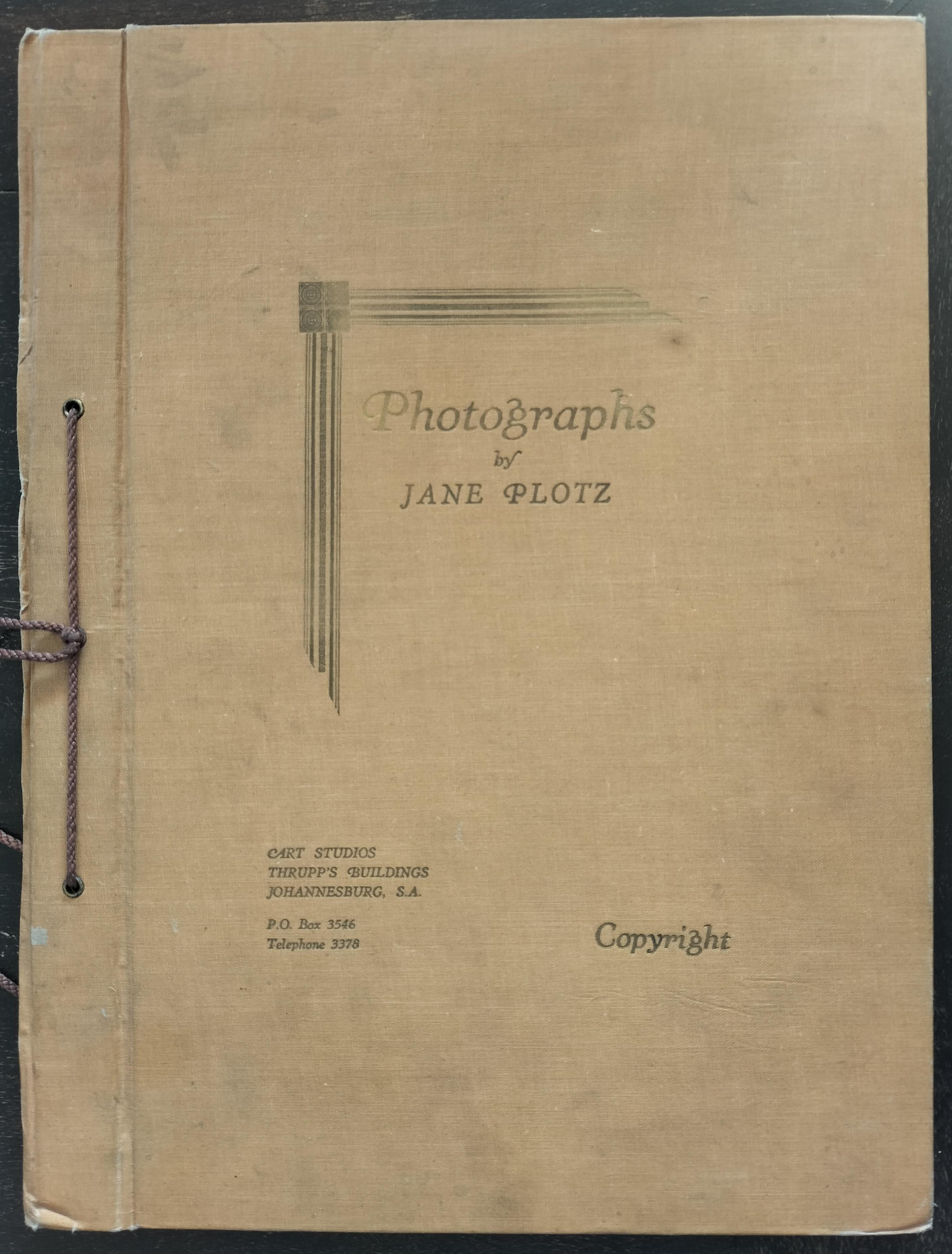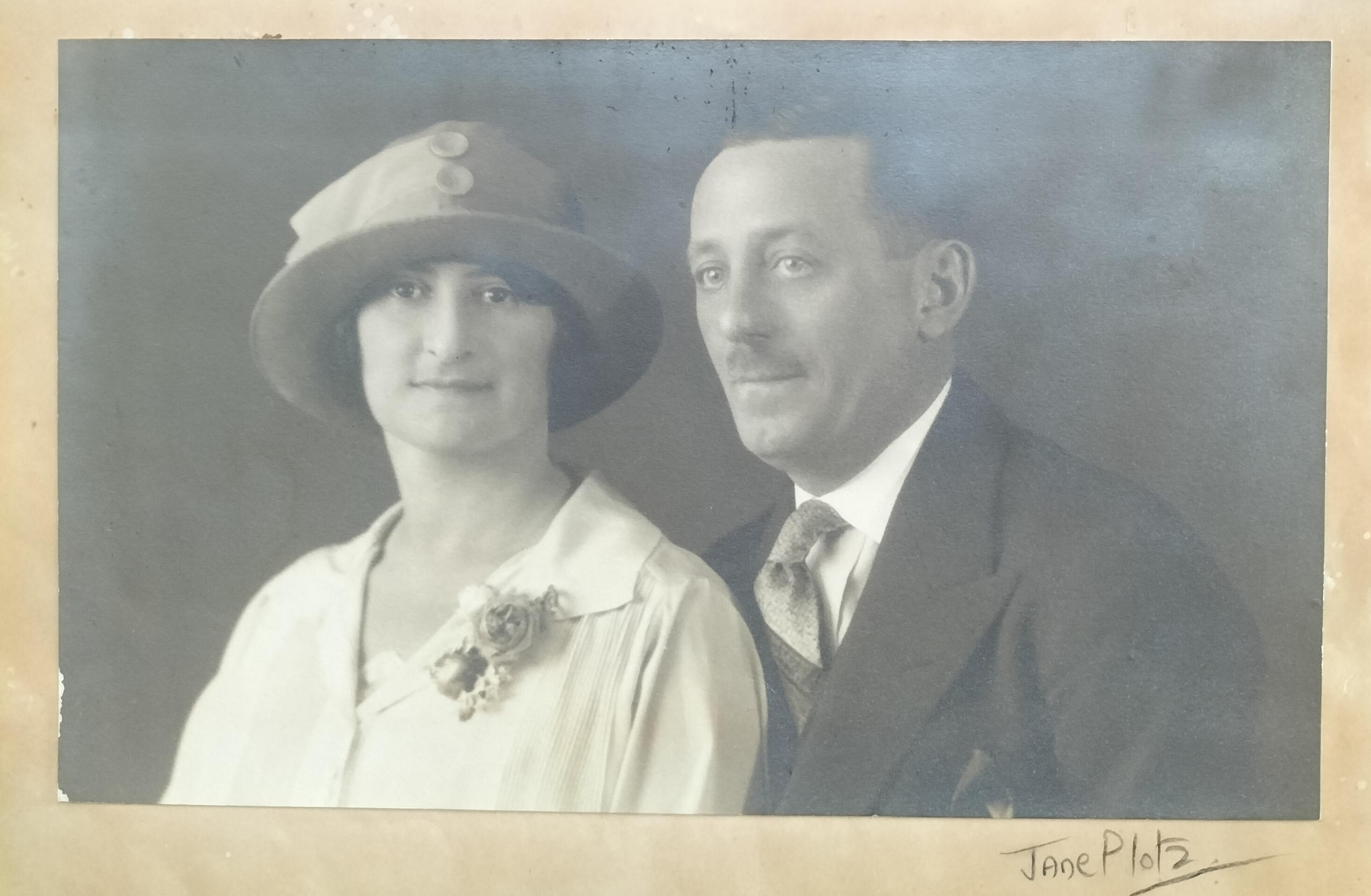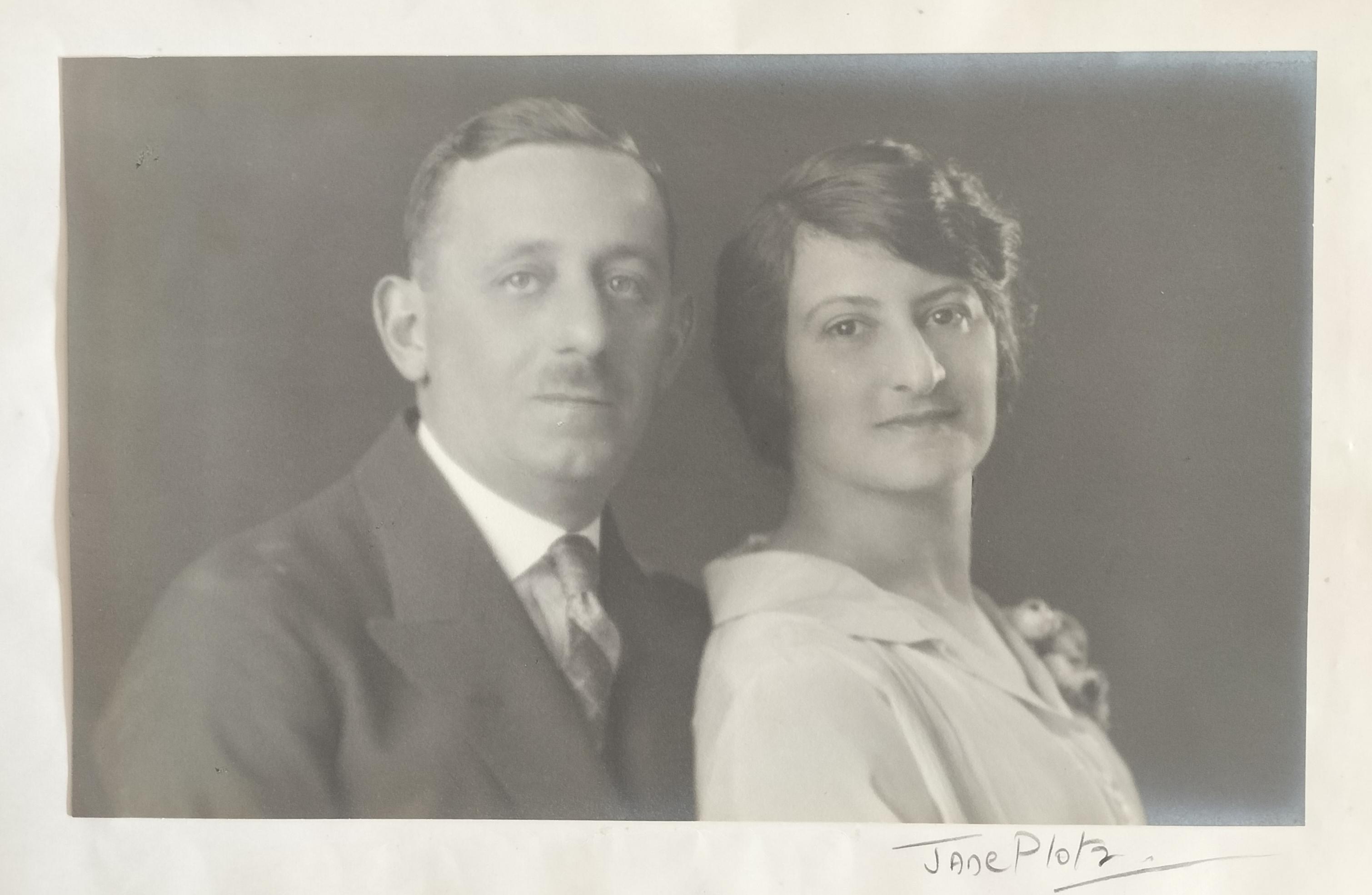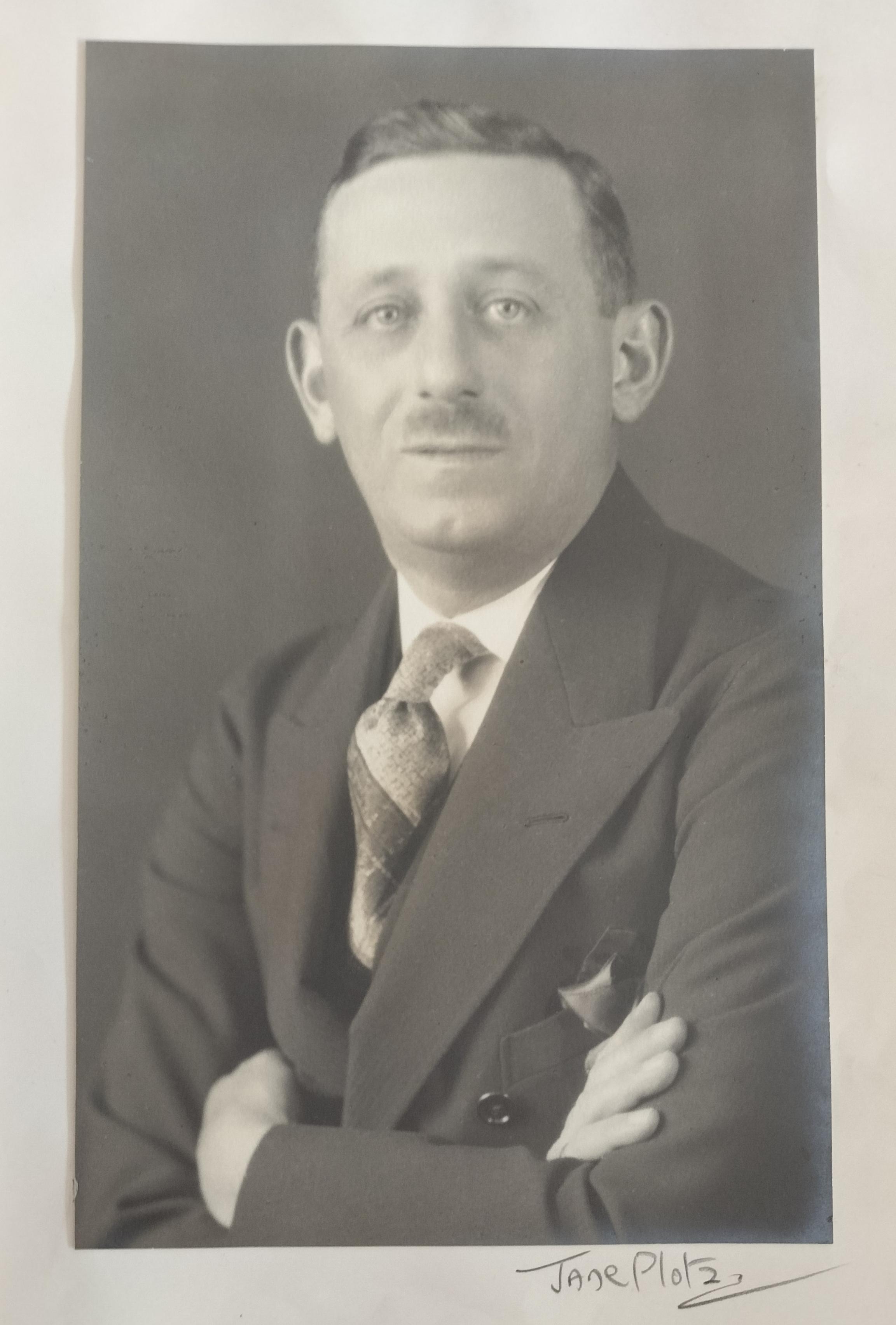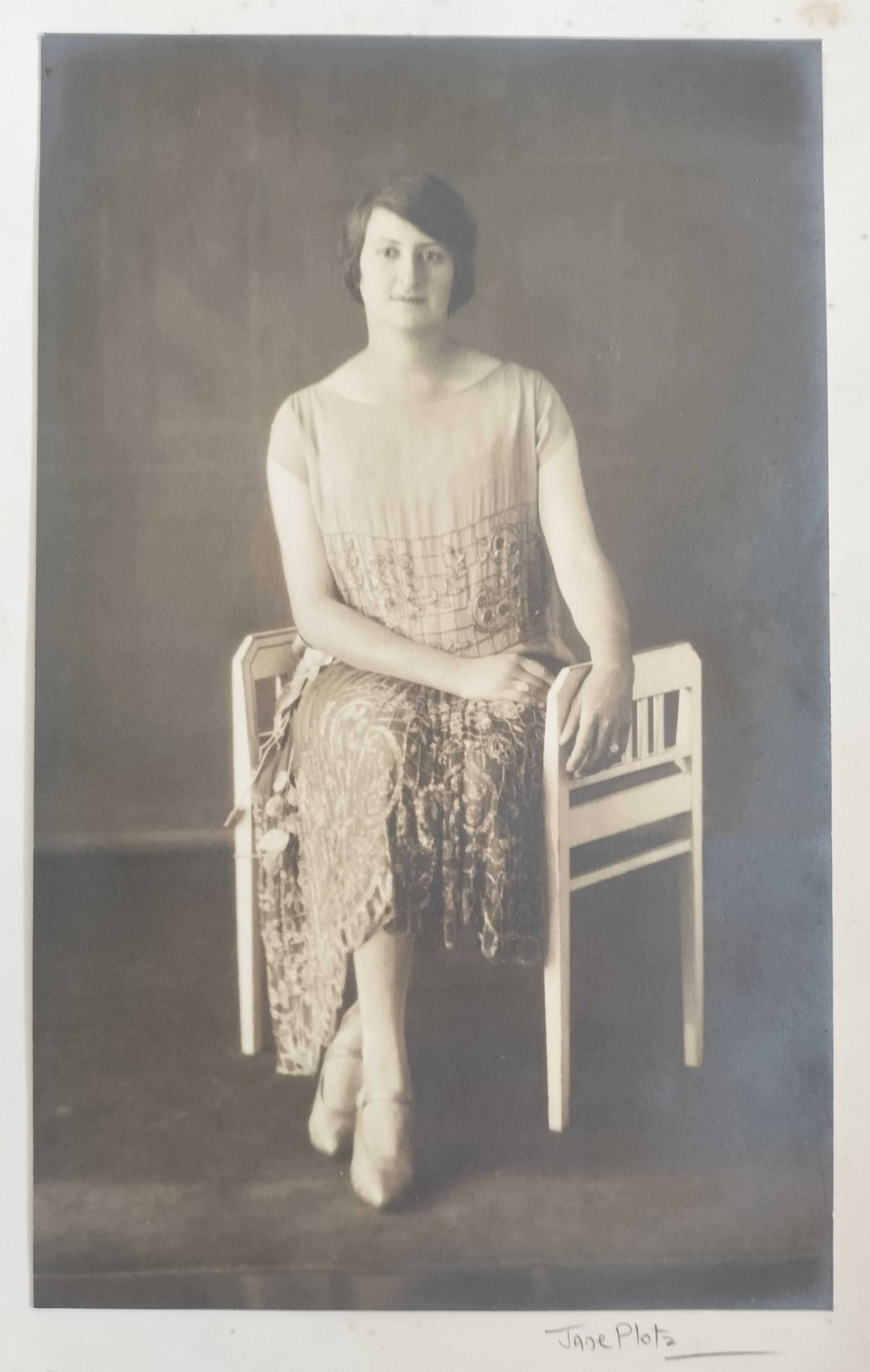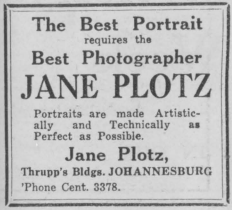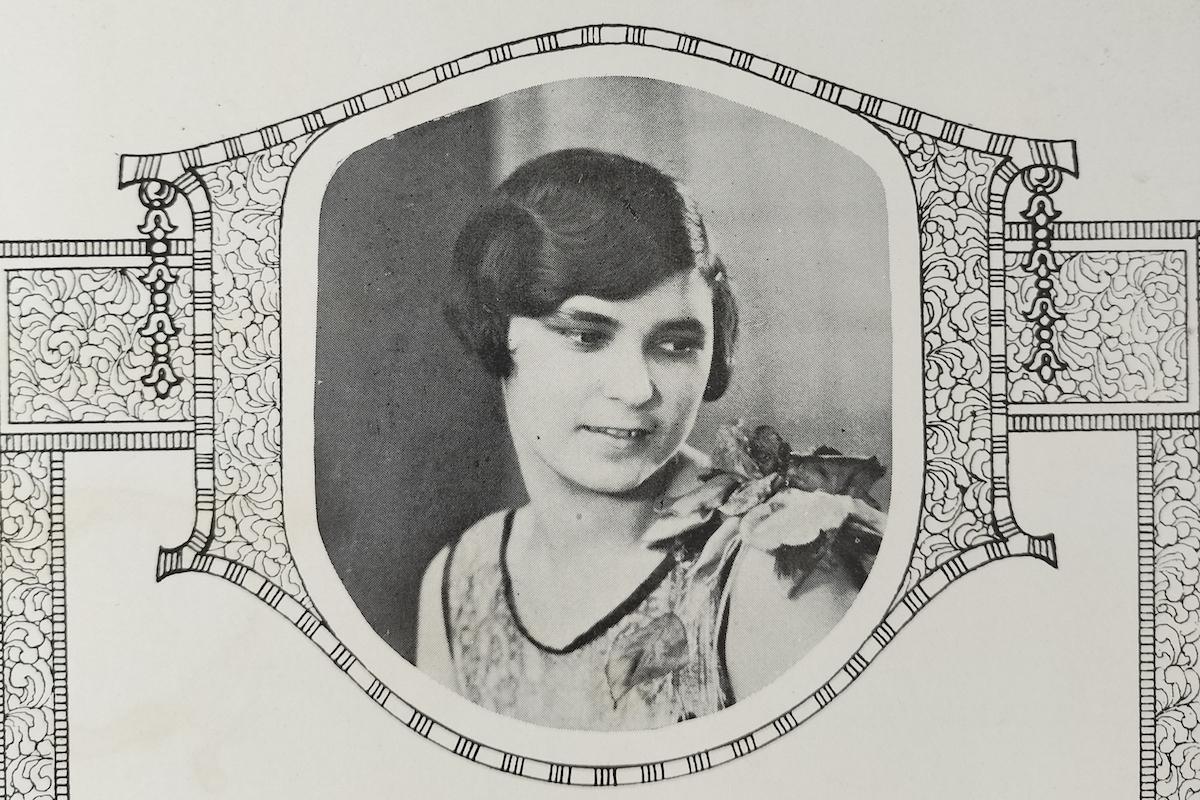
Disclaimer: Any views expressed by individuals and organisations are their own and do not in any way represent the views of The Heritage Portal. If you find any mistakes or historical inaccuracies, please contact the editor.
A few months ago, a significant photographic collection of the Johannesburg-based female photographer Sara Helena Violet Buijskes (1886 – 1970) was uncovered by Michael de Nobrega in Mosselbay resulting in an article being constructed on her live narrative (click here to read).
A single photographic portfolio curated in the Hardijzer Photographic Research Collection (HPRC) by another enigmatic Johannesburg-based female photographer, Jane Plotz, also deserves attention.
Jane Plotz would have been a contemporary to Sara Buijskes. I cannot help but wonder whether the two knew each other personally in that their respective studios (Art Studio and Barbican Studio) would have been located a few hundred meters from each other.
While Buijskes, 15 years Jane Plotz’s senior, was active as a photographer in Johannesburg since 1906 (when Jane would have been only 5 years old), Sara only opened her own studio in 1931. Jane, who relocated from Port Elizabeth, seems to have opened her Art studio in the Thrupp’s Buildings as early as 1929. Indications are therefore that Jane was active in Johannesburg as a photographer for 45 years (until 1974).
Collating information around Jane Plotz was more challenging compared to Sara Buijskes where her live narrative was easily reconstructed with family input.
Hopefully, this article may generate input from the Plotz family that has not been identified at the time of constructing this article.
Jane Plotz family
Jane Plotz, a first-generation South-African and daughter of a Lithuanian Jew, was born in Port Elizabeth in 1901.
Jane was the middle of three daughters. Their parents were Israel and Annie Plotz. Her elder sister Bella (born 1899), married Sidney Harrisberg and her younger sister Ethel (born 1907), married Leon Antoine Jean Holeyman, a colonel in the Belgian Congo at the time.
Their father was also a photographer. Whilst the Hardijzer Photographic Research Collection does not hold any photographs by Israel Plotz, records indicate that he had the studio Plotz & Company in Port Elizabeth. It is assumed that Israel took his middle daughter under his wings in his studio after she completed her schooling at East London Girls High around 1919 (Claredon High School for Girls today). Jane probably started her photographic career off by assisting him in his Port Elizabeth-based studio.
The family relocated to Johannesburg late 1920s where Jane’s solo career as a photographer took off.
On 15 July 1931, Jane married 41-year-old Russian-born (19 June 1890) medical practitioner Nathan Finn in Johannesburg. The couple’s marriage certificate confirms that Jane, 12 years Nathan’s junior, was already active as a photographer by the age of twenty-nine.
Finn studied at the University of Budapest (where he graduated in 1915) and subsequently worked in the city as a medical practitioner before immigrating to South Africa in 1925. He furthered his studies at the Royal College of Edinburgh. During his first six years in South Africa, he practised in both East London and Cape Town before settling in Johannesburg where he became a renowned rheumatic specialist.
Jane Plotz in 1945 (JewishGen)
Nathan Finn in 1945, husband to Jane Plotz (JewishGen)
It is assumed that the couple only had one daughter, Isadora Riverle Finn (born 27 July 1938). In 1960 Isadora married attorney Philip Joseph Hare. Isadora was a social worker. The couple had three children in South Africa before emigrating to the United States in 1974 where Isadora gave birth to a fourth child.
Nathan Finn died on 19 March 1965 in Johannesburg.
To date, it could not be determined when or where Jane passed away. The assumption is made that she passed away in Johannesburg during the mid-1970s.
Career
Jane was a talented musician. She studied music (pianoforte) at Maude Harrison’s Conservatoire of Music (Johannesburg) and obtained a Universal Licensing Music (ULM) qualification in both performing and teaching.
Jane however chose photography over music as a career and opened her photography studio in the Thrupp’s Building on 71 Pritchard Street Building (near the Johannesburg High Court). This building, the second Thrupp’s building in Johannesburg, opened in 1902.
The Thrupp's building in Pritchard Street - the second building on the right (with two white gables), looking west, where Jane Plotz's Art Studio was located. Although this photograph was taken some 20 years prior to Jane opening her studio, it still provides a sense of where she was based. C.H. Thrupp had his offices on the ground floor, so Jane's studio would have been either on the second or third floor. This building was located near the Johannesburg High Court. Plotz's female competition, Sara Buijskes's studio was in Rissik Street ahead (on the left).
The same building earlier also housed the New York Studios. It is assumed that Jane took over this existing studio in 1929. At this point, it is not known who the original proprietor of the New York Studio was.
Jane quickly became regarded as a top celebrity portrait photographer, photographing many visiting entertainers and celebrities performing in the city. Bensusan (1966) also acknowledges Jane as a prominent Johannesburg-based female photographer.
Jane is regarded as one of the first woman entrepreneurs in South Africa. She was also a member of the Business and Professional Women’s Club in Johannesburg (Affiliated to the World Business and Professional Women’s Clubs), as well as the Transvaal Institute of Professional Photographers.
Simonson (2023) indicates that Jane photographed David Goldblatt as a 4-year-old boy around 1934. Goldblatt (1930 – 2018) was to become one of South Africa’s most celebrated photographers of all time.
Some of Jane’s photographs were published in the photographic magazine of the time, Amateur Photographer as early as 1933. Jane also did not shy away from taking female nude photographs (at the time of constructing this article, one such image could be seen on the internet).
Jane also advertised that she did portraits in oils, pastels, crayons, black and white drawings as well as hand-painted miniatures on opals. Her artistic flair possibly explains why she would have known Irma Stern and had Irma produce a portrait of her in 1933 (see image below).
Jane Plotz portrait by Irma Stern (1933)
Only one solo exhibition held by Jane, at the Royal Photographic Society’s London gallery in 1933, has been recorded. She also became an Associate of the Royal Photographic Society (ARPS). Jane was also a member of an Automobile Club. Her hobbies included motoring, painting, music, and tennis.
Jane claimed to have conceived the idea of binding multiple photographs into a single portfolio and that she has therefore protected this idea of hers with copyright protection.
In the photographic portfolio she advertises:
The Charm of a Beautiful Portrait
When you want perfection have a Jane Plotz photograph
The word ‘Best’: Consider the word ‘best’, nearly every photographer uses it in describing his photographs. I am no exception to this rule: I use the word ‘best’ myself; in fact, I have to.
Jane Plotz portraits deliberately make up to the standard set by that word; they are made Better and Better.
Practically every photographer makes quite good photographs – I know them all. Still there must be one “Best”.
Thousands of photographs are proving irresistible – by the huge demand – of JANE PLOTZ PORTRAITS, therefore, I am in a position clearly to state that they are, without an atom of doubt, the best all-round portraits today. They succeed by sheer merit.
A collection of portraits, tastefully bound, of yourself, your loved ones or your dear friends, will be a living memory, and will gain in interest and value as the years roll on. JANE PLOTZ conceived this idea and has protected the same by copyright.
Her reference to the “his” above confirms that she worked in a very competitive male-dominated industry.
Full page advertisement included at the back of photographic portfolios produced by Jane Plotz
Jane Plotz Copyright Portfolio of the Widman couple
This article relies on a single photographic portfolio dating from the late 1940s or early 1950s. The content, produced by Jane, is of the ex-Johannesburg Mayor Alfred Bernard Widman (1921 – 2013) and his wife Rebecca (Becky) Widman (née Margolis) (1925 – 2007). The portfolio contains 9 images of Alf and Becky Widman.
Alf Widman was a Johannesburg city councilor for 16 years and became the city’s mayor between 1971 and 1972. It has been suggested that Widman introduced smoking by-laws to make theatres and cinemas non-smoking zones.
Widman became an admitted attorney in 1948 and a conveyancer in 1949. He managed his own legal firm between 1953 and 1978.
Front cover of a photographic portfolio produced by Jan Plotz. The Art Studio was based in the Thrupp's building in Pritchard Street, Johannesburg
Alfred and Becky Widman (circa 1940s). Photography by Jane Plotz
Alfred and Becky Widman (circa 1940s). Photograph by Jane Plotz
Alfred Widman (circa 1940s). Widman was the Johannesburg Mayor between 1971 and 1972. Photograph by Jane Plotz
Becky Widman (circa 1940s). Photograph by Jane Plotz
Conclusion
Several questions remain unanswered around Jane. One of those is whether she and Nathan only had one child? Attempted communication with identified family residing in the USA has gone unanswered.
On searching the internet two aspects relating to Jane may assist future research, namely:
- A presentation on Jane’s legacy by a family member (probably a niece). This presentation of an unknown date took place at the Appolonia. I could not figure out where this location was, assuming that it must have been in South Africa
- An unknown History of Arts master’s degree student enquiring via a genealogy website in 2020 for information to assist her in her research on Jane.
Also, in 2015, an exhibition of Jane’s work was held at Museum Africa. It is assumed that some of her artwork and photographs may have been donated to the Museum. At the time of publishing this article, I had no response to my enquiry on the nature and content of this exhibition.
Should any of this information eventually surface, it will most certainly enrich the brief synopsis on Jane as encapsulated in this article.
Jane and her professional artwork simply cannot be ignored in that it is deserving of due recognition.
Out there must be more photographs, photographic portfolios as well as artwork produced by Jane Plotz – It will become my dedication to identify as many of these as possible – in memory of an outstanding all-round artists.
A Jane Plotz advertisement (image reproduced from The Zionist Record)
About the author: Carol is passionate about South African Photographica – anything and everything to do with the history of photography. He not only collects anything relating to photography, but also extensively conducts research in this field. He has published a variety of articles on this topic and assisted a publisher and fellow researchers in the field. Of particular interest to Carol are historical South African photographs. He is conducting research on South African based photographers from before 1910. Carol has one of the largest private photographic collections in South Africa.
Sources
- Ball, J. (2017). The buildings of C.H. Thrupp and company over the decades. (theheritageportal.co.za)
- Bensusan, A.D. (1966). Silver Images. History of Photography in Africa. Timmins. Cape Town
- Fyfe, G. & Jammine, Y. (1998). People Practices and Admissions – Alfred Widman celebrates 50 years in practice. De Rebus (December 1998)
- Hardijzer, C.H. & de Nobrega, M. (2023). A remarkable Johannesburg-based female portrait artist: Sara Buijskes (1886 – 1970). (thehertigateportal.co.za)
- Hardijzer Photographic Research Collection (HPRC)
- Norwich, O.I. (1986). A Johannesburg Album – Historical postcards. Donker - Johannesburg
- Rabinowitz, A. (nd). The South African Jewish Yearbook database. (1929) – Jane Plotz. (www.jewishgen.org/databases)
- Rabinowitz, A. (nd). The South African Jewish Yearbook database. (1945) – Jane Plotz. (www.jewishgen.org/databases)
- Rabinowitz, A. (nd). The South African Jewish Yearbook database. (1945) – Nathan Finn. (www.jewishgen.org/databases)
- Simonson, K. (2023). South African Jewish Photography: Eastern European Immigrants and the Western European Canon (Menotyra). (www.ceeol.com)
- Unknown (1933). The Zionist Record. Sundigital collections. (www.digital.lib.sun.ac.za)
- Unknown (extracted 20 February 2024). Phillip Hare obituary. (www.legacy.com)
Comments will load below. If for any reason none appear click here for some troubleshooting tips. If you would like to post a comment and need instructions click here.

